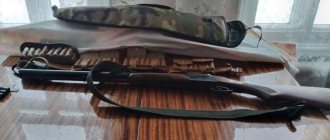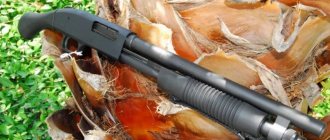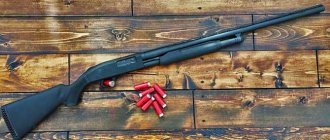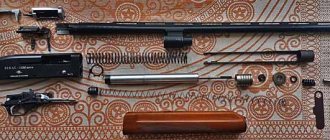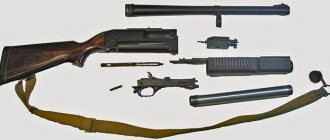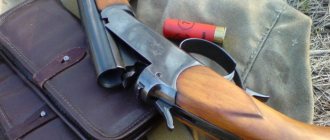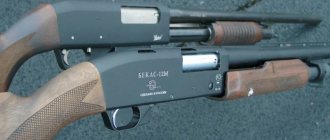Personal weapons have always been a very sensitive topic. However, after a surge in crime in the 90s, many weapons found their way into civilian markets. Some of the production samples have long since left the fresh part of the market, gathering dust in warehouses as recyclable materials.
Among the entire hunting arsenal, the Izh-81 civilian pump-action shotgun is in a special place - it has not yet completely used up its resource, is still in demand and profitable. In this article we will examine in detail the reasons for the popularity of this model produced by the Izhevsk Arms Plant.
Features of the gun
According to weapons experts, the IZH-81 shotgun can be considered a leader in the group of pump-action models. In the West, such weapons have been used for training and hunting purposes for several decades. In addition, it is difficult to remember the name of at least one special forces in government agencies that does not use a similar shotgun to protect the population. Pump-action shotguns owe their popularity to their main features:
- large chamber capacity (from 4+1 to 12+1 ammunition);
- fast reloading due to the pump system;
- pistol grip with improved ergonomics.
IZH 81 with pistol grip and folding stock
All this is typical for the IZH-81, since this gun has many similarities with products from the world's leading guns, Mosberg, Winchester and others. However, pump-action shotguns are not designed for shooting at long distances, which means using them in their “pure form” for hunting will not be very rational. The situation is saved by modifications, of which the IZH-81 has many.
Notes[ | ]
- ↑ 1234567
IZH-81 // A.I. Blagovestov. What they shoot from in the CIS: Directory of small arms. / edited by A.E. Taras. Minsk, “Harvest”, 2000. p.564-565 - ↑ 123
A. V. Kuzminsky. Weapons for the hunter: a practical guide / edited by. A.E. Tarasa M., AST Publishing House LLC, 2002. p.217 - Nikolay Aksenov. New items-2000 // “Weapon” magazine, No. 8, 2000. p.20-28
- Alexander Kalugin, Marat Sibiryakov. Self-loading "Izhmekha": from concept to production // Kalashnikov magazine. Weapon. Ammunition. Equipment", No. 9, 2012. pp. 34-36
- magazine "Kalashnikov. Weapons, ammunition, equipment", No. 2, 2000
- Zoran Milosevic. Foreign special forces: “Bosna”: Police special forces Archived copy dated July 25, 2022 on the Wayback Machine // “Brother” magazine, February 2013
- Decree of the Government of the Republic of Kazakhstan No. 65 of January 22, 2004 “On approval of categories of customs officials performing the functions of law enforcement agencies in accordance with legislative acts, entitled to carry, store and use firearms, lists of types of firearms and ammunition and special means, applied by customs officials"
- Armament Archived copy dated September 14, 2013 on the Wayback Machine / private security website (Kazakhstan)
- « 2.3.2.
Smooth-bore hunting firearms... 16. Single-barreled multi-shot shotgun IZH-81 cal. 12/70; 12/76 » Order of the Government of the Russian Federation No. 1207-r dated August 3, 1996 “List of service and civilian weapons and ammunition included in the State Cadastre of service and civilian weapons” - Decree of the Government of the Russian Federation No. 587 of August 14, 1992 “Issues of private detective and security activities”
- “ 3. Establish that firearms purchased in accordance with the legislation of the Russian Federation by non-state (private) security companies before the entry into force of this resolution and not included in the list of types of weapons for security guards approved by Decree of the Government of the Russian Federation of August 14, 1992 N 587 (as amended by this resolution), may be in service with security guards until March 1, 2006.
» Decree of the Government of the Russian Federation No. 179 of April 4, 2005 - Igor Skrylev. Gun reserve of a private security guard: from “Bekas” to “Saiga” // “World of Security”, April 2000, pp. 50-51
Design and principle of operation
The basic operating principle of a pump-action shotgun is tailored to its fast reloading system. To release the spent cartridge case from the chamber, simply move the forend back. At the same second, the ejector mechanism will operate and the cartridge will fly to the side. At the moment the chamber closes (when the pump moves forward), a new cartridge is fed into the barrel. Thanks to such a fast system, the shooter can fire from 40 to 60 rounds per minute, provided there is unlimited ammunition.
Depending on which modification of the IZH-81 was chosen by a connoisseur of smooth-bore weapons, the design of the pump-action shotgun may differ. However, in all cases, the model will be equipped with a barrel locking system, which will not allow the shooter to fire until the pump returns to its original position. Also, all models are connected by a sliding bolt designed to equalize the pressure generated by the powder gases.
The design of the IZH-81 pump-action shotgun
How does it work?
After the shot has been fired, the forend moves back, as a result of which the barrel channel opens. At the same time, the spent cartridge case is extracted from the chamber. A new cartridge is supplied from the magazine and the trigger is cocked automatically. In order to send ammunition into the chamber, you need to move the forend forward. Judging by the reviews of the owners, the IZH-81 has a high reload speed.
Specifications
The tactical and technical characteristics of pump-action weapons are something that has always been the subject of many rumors and myths. For example, some owners claim that the firing power of such a weapon is so great that it pierces a concrete wall whose thickness is 20 centimeters. However, we will not believe everything that they write, but simply take a look at the indicators indicated in the IZH-81 weapons passport:
| Characteristic | Parameter |
| Caliber | 12 |
| Barrel length | 560 mm |
| Chamber capacity | 4 ammunition |
| Shot energy | 95 J |
| Combat accuracy | 45% |
| Weapon weight | 3.2 kg |
Thus, the power of the weapon is truly impressive, but only at short distances (up to 40 meters). Due to the relatively short barrel, the accuracy of the fire is also not the best. Although it should be noted that there are modifications with increased performance, tailored for hunting.
IZH-81 has a fairly high shot power
Update 1. Addition based on information from the magazine “Russian Small Arms”
Addition based on information from the magazine “Russian Small Arms”, special issue, historical series, issue 6, “Pneumatic Weapons”. Article “His name was SPP.”
Let me say right away that I do not agree with everything written in this article, but I will still provide some information from it.
The copy of the SPP described in the article was produced in 1946. It also has a lined, but already rifled barrel. And with reference to M. Blum’s book “Sporting Weapons” (1954), the same hypothesis is repeated that, probably, some of the SPP copies were produced with a rifled barrel, and some with a smooth one.
According to the summary table from the same magazine, from 1945 to 1947 (the entire period of production of the SPP) 54,890 copies were produced.
A rather strange SPP numbering system emerges: the copy given in the article has the number ZhK4784 and the year of manufacture 1946. My copy has the number DR2244 and the year of manufacture 1945, and the pistol in Hans’s article has a completely different arrangement of marks and, apparently, the number OK405 and the year of manufacture 1945. I was not really able to understand the logic of such numbering - in fact, even two letters and three numbers should have been enough for at least half a million copies, but here they were released much less. Either the numbering was common to all pneumatic (and even small arms) products of IzhMech, or the letters carry a certain meaning and their combinations are very limited. The second part of the description of the SPP (Izh-45)
Advantages and disadvantages
To understand whether the IZH-81 is worth the money, it is recommended to study the main positive and negative aspects of the weapon. Let's start with the advantages over foreign analogues, since there are really a lot of them:
- short stroke length of the forend (9.5 cm) - ensures faster reloading;
- relatively small weight with a butt (up to 3.4 kg) - adds mobility to the hunter;
- excellent ergonomics ensured by a comfortable handle and good balance;
- spacious magazine - up to 7 rounds in modified versions;
- good wear resistance is the merit of high-quality steel type A50.
The cost of a used gun ranges from 4 to 12 thousand rubles, which is quite a bit for a smooth-bore hunting weapon. However, this does not mean that a model purchased second-hand will necessarily have some hidden problems.
Unfortunately, not a single barrel of honey is complete without a fly in the ointment, especially when it comes to domestic weapons. Here is a list of the main shortcomings that IZH-81 owners most often complain about:
- low sighting range - up to 40 meters;
- The quality of the barrel lock is not the best - sometimes it opens;
- Quite a complex design - tools will be required for disassembly.
The sighting range of a pump-action shotgun is up to 40 meters
Well, don’t forget that the IZH-81 gun in its original form is not suitable for hunting - there are modifications for this. But for training or self-defense, the model is very useful.
Opening the shutter after firing an IZH-81
Opening the shutter after firing an IZH-81#10
IZH-81
Dear Mr. Kuznetsov!
The phenomenon of the bolt opening after a shot with a weak hold that you describe is typical of most guns with reloading with a moving fore-end, especially after some shooting and running-in. A new gun usually has a greater force in moving the fore-end along the magazine tube and the bolt in the box, so the fore-end is less likely to be thrown off.
When shooting a Winchester 1200 with a weak handguard, it was found that often after firing the cartridge case was half removed from the chamber. Of the two IZH-81 guns, after firing 2000 rounds, the bolt opened slightly on one.
Upon inspection, no element was found that brakes the forend in the extreme position on the Beretta RS 202 P, Franchi RA7, on the classic Ithaca 37, Remington 870. Such a brake is only available on the Winchester 12 gun: a small section of the magazine tube is cut and bent outward, acting as a leaf spring . The opening of the shutter is especially noticeable when shooting “drawn” - when the shooter pulls the fore-end back before firing to speed up reloading or simply due to insufficient arm length.
The described phenomenon is due to the fact that the forend, the movement of which is used for reloading, has a fairly large mass and, when fired, experiences significant inertial loads. When fired, the gun, together with the shoulder, is first thrown back by the force of recoil, then returned forward due to the elasticity of the support (arrow). When the gun returns forward, the loose forend, due to its inertia, tends to remain in the same place where it moved along with the gun. The gun moves forward relative to the forend remaining in place, and the bolt opens slightly. The amount of opening depends on the friction forces, the power of the shot, and the effort to remove the cartridge case from the chamber. In some action films you can see such a gun being reloaded by inertial “shaking” while holding the fore-end with one hand.
All this has nothing to do with the reliability of the locking. Unlocking the bolt on the IZH-81 begins only after the forend moves back about 8 mm. At the moment of firing, the wedge that engages the bolt with the barrel coupling cannot lower. The reliability of locking can be assessed by connecting the bolt to the barrel without a box, in an assembled gun, by the imprint of the bolt on the paint, a drop of wax, or a piece of plasticine placed on the locking surface of the barrel coupling.
If someone finds the phenomenon of the bolt opening slightly unpleasant and it will be difficult to get used to holding the gun normally, you can try introducing a braking element. For example, apply a drop of lead-tin solder to the magazine tube with a soldering iron.
Gun modification
Over the entire period of its existence (more than 20 years), the IZH-81 gun has acquired an extensive list of modifications, each of which is tailored for a specific purpose - from self-defense to hunting. If a person wants to get a multitasking model, then it’s worth stopping at the “clean” version. Everyone else is advised to pay attention to the following models.
IZH-81M, IZH-81K, IZH-81KM
The first model on this list is a simple modification chambered for Magnum-type cartridges (12/76 mm), intended for hunting large game. The gun with the “K” index in its name complements the existing weapon with a box magazine, and also increases the barrel length to 700 millimeters.
Shotgun IZH-81KM with a wooden butt
The IZH-81KM model is a modified version with Magnum cartridges, as well as a box magazine - one of the most complete guns for hunting.
IZH-81 "Fox Terrier"
A modification of the standard IZH-81 shotgun, developed for law enforcement agencies, as well as security structures. The difference between the two models is the length of the barrel (in the Fox Terrier it is 600 mm), as well as the material from which the butt is made (plastic with a high polymer content, instead of standard wood). The gun will also perform well in hunting, as it has an increased sighting range of up to 50 meters.
IZH-81 Fox Terrier with pistol grip and folding stock
IZH-81 "Jaguar"
Just like the Fox Terrier, the IZH-81 Jaguar is used primarily by private security companies and special forces of law enforcement agencies. However, this model does not include a stock and also has a shortened barrel (560 mm). Because of this, it becomes comfortable to use a pump-action shotgun only at short distances (from 35 to 40 meters). But the Jaguar is equipped with a comfortable pistol grip.
IZH-81 Jaguar pump-action shotgun
MP-133
This weapon is not a modification of the IZH-81, but many hunters are accustomed to thinking so. In fact, the MP-133 is an independent model that was produced until 2000 on the basis of an old pump-action shotgun. The difference from the original is a simplified design, as well as improved technical characteristics. The barrels can be equipped with additional choke-type choke tubes, which will appeal to fans of weapon tuning.
MP-133 pump-action shotgun
Design
Structurally, the IZH-18 is not much different from the smooth-bore weapons produced in the pre-war years. However, the engineers still managed to introduce several features characteristic of a certain part of the weapon.
Trunk
The barrel of the MP-18 shotgun is connected to the block using a special under-barrel hinge and trigger. Most modifications are produced without a sighting rib, but in any case there is a metal front sight at the end of the barrel. Depending on the caliber, the length of the muzzle channel varies from 620 to 750 millimeters. And the greater the distance inside the barrel a ballistic projectile travels, the greater the accuracy of the hit it has.
Most IZH-18 models have a constant choke, which ranges from 0.5 to 1 millimeter. Such guns are marked "Var" on the breech and do not have the ability to modify the barrel. If the muzzle constriction is removable, then at the end of the cut there will certainly be a recessed flush section intended for tightening the constriction. With this feature, the hunter can check the locking of the muzzle attachment directly during the hunt after each shot.
IZH-18 barrel markings
Another feature of the barrel is that it is chrome plated, as is the chamber. This is done in order to increase the service life of the weapon. Models that use shot as a ballistic projectile have a larger layer of chrome than those that fire bullets. These varieties can be distinguished by the “STEEL” marking at the muzzle. If such letters are carved there, it means that the gun is suitable for shooting using pellets.
Locking mechanism
A distinctive feature of the MP-18 is the single barrel locking using an under-barrel hook and hinge. The system has a special trigger lock that will prevent the shooter from firing until the barrel is completely locked. To unlock the weapon and release a whole cartridge, you will have to press a special lever located at the rear of the receiver. This function will seem especially useful if the cartridge misfires.
Underbarrel hook and locking mechanism
Trigger mechanism
The USM (trigger mechanism) of the IZH-18 shotgun is completely located in the receiver - only the trigger sticks out. The mechanism of action of the striker is almost no different from the standard used during the manufacture of smooth-bore guns. The shot is fired under the action of a spring, after which the trigger rebounds and moves backward.
The main distinguishing feature of the MP-18 trigger is the smooth release of the trigger, which can be set to safety after cocking the release lever to the “Fire” mode. There is also a “petal” cocking indicator on the block, so the hunter can see whether the weapon is loaded. In the dark, this “indicator” can be easily felt with a finger.
USM MP-18 circuit diagram
Fuse
The non-automatic push-button safety of the IZH-18 shotgun is a small flag that can take two positions: ON and OFF. When the weapon is in fire mode, a red mark becomes visible on the left side of the safety, signaling that you should be careful when handling a loaded MP-18. If the model is discharged, then the fuse will cover this very mark.
Hunting rifle safety
The trigger is locked using a standard sear. Even if the weapon falls to the ground at the moment of combat readiness, the shot will not fire, since the protrusion of the trigger will not hit the firing pin. Also, additional safety is provided by the safety locking mechanism, which does not allow the hunter to fire a shot if the barrel is not completely locked - the firing pin simply will not reach the firing pin.
Butt
Typically, the IZH-18 stock is made of walnut or beech, but there are rarer modifications, for example, from birch. The neck of the stock is almost always pistol. The direct version is used only in those models that are intended for shooting with bullets and darts. The butt end is often equipped with a rubber butt pad, which slightly reduces recoil and improves ergonomics. Some modifications can also be equipped with a plastic stock, which is lighter in weight and is not susceptible to excess moisture.
Stock and handguard for MP-18
Disassembly and care
Any gun loves cleanliness and lubrication, and the IZH-81 is no exception in this regard. Before you begin the maintenance procedure, you will first have to completely disassemble the model. To do this, you need to follow a certain algorithm of actions:
- We unscrew the support nut, which is located at the barrel magazine.
- Pull the forend all the way down so that it is at the base of the barrel.
- We pull the forend towards ourselves and pull out the bolt along with the magazine.
- We take a small chisel and a mallet - they will be needed to disassemble the trigger.
- We knock out all the pins and couplings from the trigger mechanism.
- We do the same with the butt (if there is one).
IZH-81 pump gun disassembled
To reassemble the weapon, you will need to perform the steps in the same sequence, but from bottom to top. As for the tools that may be required during the assembly and disassembly process, their list is limited to the following:
- flat screwdriver;
- thin chisel;
- mallet.
Keep in mind that most of the small parts are mounted on pins and couplings, so you won't need to use a lot of tools to remove them. Simply knock out the fastening element with a mallet and remove it to the side.
Once the complete disassembly of the weapon is completed, you can begin the process of cleaning the lead coating. This must be done after each use of the weapon, otherwise it will be very difficult to remove dirt later. Here are the instructions for a thorough cleaning:
- We take a copper (for light contamination) or steel (to remove leaded deposits) brush and place it in the barrel channel. After this, you need to start performing progressive movements up and down for 5 minutes in order to remove all the dirt.
- We moisten a piece of rags or medical cotton wool in kerosene, and then place the material on the cleaning rod. This device is used to get rid of old oil residues. During the process, you will need to re-wet the material with kerosene several times.
- We thoroughly wash the barrel under running water using any detergent (Fairy, AOS). A soap solution will get rid of kerosene residues in the barrel, and water will rinse out all foreign debris.
After this, all that remains is to dry the barrel by placing it in a dry room. It is not recommended to carry out the procedure near a boiler or radiator, since the air temperature there may be too high. It is best to use an attic or just a warm room.
Once all the water has been removed from the barrel, lubrication can begin. With the use of modern oils in the form of a spray, the procedure is quite quick and easy - just place the spray tube in the barrel and make a few presses. You can evenly distribute the composition along the trunk using a cleaning rod. Small parts (like the trigger) are lubricated with the same oil, but every 5-6 months.
About materials
For the manufacture of barrels, strong weapon steel is used, which is used in the production of Kalashnikov assault rifles. The inside of the barrel channel contains a chrome coating. For the receivers, they do not use ordinary weapon steel, but a special aluminum alloy, which reduces the weight of the pump action. According to experts, in order to reduce the impact of the bolt mechanism on the box, weapons designers had to abandon the use of heavy metals. In the manufacture of butts, plastic and walnut, beech or birch wood are used.
Where is it used?
Historically, pump-action shotguns are used mainly in European and American countries, so it is not surprising that Bosnia and Herzegovina still uses the IZH-81 to arm special law enforcement units. The model is very popular among police officers in Kazakhstan. In Russia, guns are mainly used by private security companies or hunters.
IZH-81 is used by both hunters and security forces
IZH-81 is the best example of a pump-action shotgun among domestic weapons. Despite the fact that the model was developed for self-defense and still belongs to the category of civilian weapons, people have found use for it in other areas. The modified versions will be especially pleasant to use, since they have improved combat characteristics and ergonomics.
False start
In the early 70s, there was a need in the country for a new compact SUV aimed at rural bosses. Of course, at that time there was a trouble-free UAZ, but its militaristic essence was more suitable for the military, and not for the chairmen of collective farms. The latter just wanted to get a comfortable, not a Spartan car.
The wishes of the farmers were heard at the top. And Izhmash specialists were the first to get down to business. Soon they had their first prototype, the Izh-5. By this time AvtoVAZ also woke up. There they began work on the Niva.
But, let's return to Izhevsk. In the end, they did not work on the “five”. But it formed the basis of another model - the Izh-14. It was the first frameless short-wheelbase “rogue” with all-wheel drive in the history of the USSR. Its appearance occurred already in 1972.
Outwardly, it looked quite decent (especially considering the time and the fact that the model was a prototype). Vladimir Savelyev worked on the design of the SUV. In addition to the new look, the car also received a new transfer case. Its main difference was that it made it possible to engage both the front axle and the rear axle with just one lever, and both at once with the engagement of a lower gear. Out of habit, we took the front suspension from Moskvich, we just worked on strengthening it. But the company’s plans included replacing it with McPherson. Initially, the creators wanted to use a torsion bar rear suspension, but decided not to rush. Therefore, springs from Moskvich-412 were used. The leadership urged not to forget about unification with the 412th. As for the brakes, it was decided to use hydraulic drums with a hydraulic vacuum booster.
It is interesting that Ustinov himself personally arrived at the plant to receive the Izh-14 prototype. The Secretary of the Central Committee, together with his retinue, got into a car and drove around the territory of the enterprise. And, despite the fact that the “fourteenth” was not run-in (the company didn’t think that Ustinov would want to take it for a ride), the boss liked the car. It seemed that the ambitious project had been given the green light. But it wasn't that simple.

